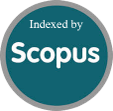Analysis of socioeconomic factors supported by a principal component model as a predictor of property tax collection, San Martín-Perú
DOI:
https://doi.org/10.51798/sijis.v2i2.106Keywords:
Socio-economic, property tax, tax collection.Abstract
The objective of this study was to determine the relationship between socioeconomic factors and property tax collection in the municipalities of a province in Peru and to determine the principal component analysis by socioeconomic factors and property tax collection. The research was applied and non-experimental design, with an exploratory correlational scope. The technique used was the survey and the instrument was the questionnaire to a sample of 152 taxpayers of the province; the sampling was non-probabilistic by convenience. The result indicates that there is a considerable positive correlation of 0.751 and a significance level of 0.000. Given this p-value of less than 0.05, the null hypothesis is rejected and the alternative hypothesis is accepted, of the multivariate factor analysis of principal components, variable socioeconomic factors, component 1, they consider that they contribute to the development of their district (0. 853), component 2, they consider that initiatives to collect taxes are promoted (0.796), variable property tax collection, component 1, they consider that they have been notified for non-compliance (0.865), component 2, they consider that they know the ways to pay taxes (0.747). It is concluded that there is a significant relationship between socioeconomic factors and property tax collection in the municipalities, i.e., if the socioeconomic level is high, property tax collection also improves.
References
Acuña, R., & Camacho , M. (2015). Manual para la mejora de la Recaudación del Impuesto predial (Vol. 2). Depósito Legal en la Biblioteca Nacional del Perú Nº 2015-05582.
Ali, M., Fjeldstad, O.-H., & Sjursen, I. H. (2012). Factors affecting tax compliant attitude in Africa: Evidence from Kenya, Tanzania, Uganda and South Africa. 1-26.
Arias, J. (2020). Proyecto de Tesis Guía para la elaboración. (J. Arias, Ed.) Arequipa, Arequipa, Perú: Biblioteca Nacional del Perú N°2020-05577. Obtenido de www.agogocursos.com
CONCYTEC. (2018). Guía práctica para la Identificación, categorización, priorización y evaluación de líneas de investigación. Obtenido de https://portal.concytec.gob.pe/images/publicaciones/guias-doc/guia_practica_identificacion_categorizacion_priorizacion_evaluacion_lineas_investigacion.pdf
De Cesare, C. (2016). Sistemas del impuesto predial en América Latina y el Caribe. (C. De Cesare, Ed.) by the Lincoln Institute of Land Policy, 1-9.
Decreto Supremo Nº 156-2004-EF. (2004). Aprueban Texto Único Ordenado de la Ley de Tributación Municipal.
Díaz, L., & Castro, L. (2014). Combatiendo la caída: revirtiendo la pérdida de relevancia del impuesto relevancia del impuesto. (J. Bonet, A. Muñoz, & C. Pineda, Edits.) Banco Interamericano de Desarrollo, 1-28.
Duran , L., & Mejía, M. (2015). El régimen del impuesto predial en las finanzas públicas de los gobiernos locales. Contabilidad y Negocios, 10, 43-66.
El Peruano. (28 de febrero de 2017). Obtenido de https://www3.vivienda.gob.pe/dgprvu/docs/DS%20N%C2%BA%20002-2017-VIVIENDA.pdf
Espinosa, S., Martinez, J., & Martell, C. (2018). ¿Por qué algunos municipios en México son mejores recaudadores de impuesto predial que otros? Gestión y Política Pública, XXVII(2), 375-395.
Guerrero, R., & Noriega, H. (2015). Impuesto Predial: Factores que afectan su recaudo. Económicas CUC, 36 (1): 71-80.
Jiménez, J. (2017). Equidad y sistema tributario en América Latina. Nueva Sociedad, 52-67. Obtenido de www.nuso.org
Martínez , P., Venegas, M., Escobedo, H., & García, M. (2018). La Recaudación del Impuesto Predial en el Municipio de Chihuahua: Un Análisis de las causas del resago. European Scientific Journal, 14(19), 45-62. doi:10.19044/esj.2018.v14n19p45
Quispe, J., Mamani, M., Micaela, D., & Tuesta, Y. (2019). Determinantes del imcumplimiento de pago de impuesto predial de los pobladores del barrio Bellavista de la ciudad de Puno,Perú - 2018. Revista Académica, 3(2), 65-88.
Rios, R. (2017). Metodología para la investigación y redacción (Grupo de investigación (SEJ 309) eumed.net de la Universidad de Málaga ed., Vol. Primera edición). Málaga, España: Servicios Académicos Intercontinentales S.L. Obtenido de https://www.eumed.net/libros-gratis/2017/1662/index.html
Rodrigues, J., Amorim, E., & Rios, M. (2012). The Urban Property Tax (IPTU) in Brazil: An Analysis of the Use of the Property Tax as a Revenue Source by Brazilian Municipalities. Lincoln Institute of Land Policy Working Paper, 1-61.
Ruíz, J. (2017). La cultura Tributaria y la Gestión Municipal. Quipukamayoc, 25(48), 49-60.
Sánchez, V., Huanca, L., Díaz, R., & Saldaña, L. (2020). Ingresos prediales, responsabilidad y bienestar vecinal en el distrito de Chota. Ciencia Nor@ndina, 3, 37-44.
Segura, M., & Cayao, M. (2017). Causas que generan la morosidad del impuesto predial en la Municipalidad Provincial de Moyobamba en el año 2016. Universidad Peruana Unión, 1-72.
Solano, S. (2018). Factores socioeconómicos y su influencia en la recaudación del impuesto predial en el distrito de San Martin, El Dorado 2018. Universidad Cesar Vallejo, 1-75.
Torres, J., & Torres, S. (2016). Programa de mejora de recaudación del impuesto predial en la municipalidad provincial de Mariscal Nieto. Moquegua 2015. Ciencia y Tecnología para el desarrollo, 53-59.
Downloads
Published
How to Cite
Issue
Section
License
Copyright (c) 2021 Avelino Villafuerte de la Cruz , Jhon Bautista Fasabi , Rosa Katherine Ruíz Muñoz , José L Pérez García

This work is licensed under a Creative Commons Attribution-NonCommercial-NoDerivatives 4.0 International License.




